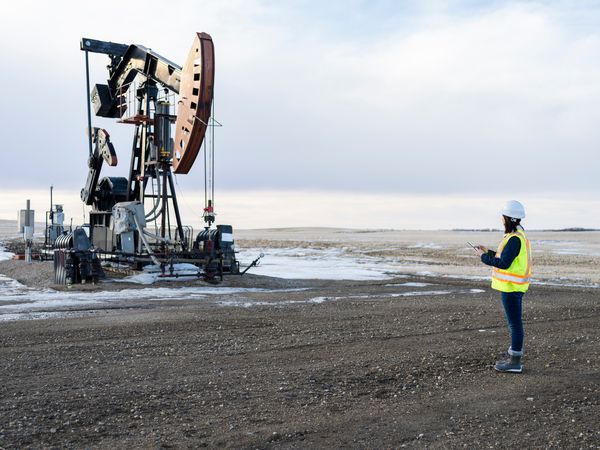MPLX (MPLX +0.92%) is trading at an eye-popping yield of more than 14%. That's much higher than the MLP's average yield since it was spun off of its parent company Marathon Petroleum (NYSE: MPC) in 2012. Like most energy companies, MPLX's operations have been hit by COVID-19. This has impacted MPLX stock, pushing its already high yield still higher. The company is taking steps to lessen the impact of current market conditions. MPLX is good at keeping its debt under control, which should help it in the current crisis.
MPLX's leverage
Despite acquisitions, and taking on debt to make them happen , MPLX has managed to keep its leverage under control. MPLX's debt-to-EBITDA ratio stands at more than 5 times. However, adjusting for noncash impairment charges, the company's debt-to-adjusted EBITDA ratio is at a comfortable level of 4.1 times. Like depreciation and amortization, impairment is a non-cash charge. As the company did not actually pay cash for this charge, it makes sense to add it back to income for arriving at adjusted EBITDA. While impairment charge reduces a company's equity, EBITDA adjusted for impairments better reflects a company's operational performance.
MPLX's debt-to-EBITDA ratio rose after each of MarkWest and Andeavor acquisitions. However, earnings from acquired assets meaningfully contributed to MPLX's earnings over the years, in turn helping to bring back the ratio to reasonable levels.
MPLX kept its quarterly distribution flat for the first quarter. The company's distributable cash flow provided a healthy coverage of 1.4 times its distributions for the quarter. Overall, MPLX's financial profile looks conservative.

Image Source: Getty Images.
The risks
MPLX surely faces a few key risks. Low gas prices are severely impacting producers in the Marcellus and Utica shale plays in the Appalachia region. MPLX has significant gas gathering and processing operations in this region. However, roughly 74% of MPLX's processing capacity in Marcellus is backed by minimum volume commitments. The Marcellus region accounts for more than half of MPLX's gathering and processing earnings. MVCs require producer customers to pay a penalty if volume commitments are not met.
In comparison, only one-fourth of the company's processing capacity in the Utica and southern Appalachia region is backed by MVCs. This exposes its earnings from the region to downside risk.
In its latest call, MPLX's management noted that a drop in associated gas production in the Permian Basin should help gas prices and producers in the Northeast. Additionally, management said that reduced crude production also reduces natural gas liquids production, which should support NGL prices as well. While this sounds positive for MPLX, current gas price makes it difficult for producers to operate profitably.
Earnings concentration
Another key risk MPLX faces is that a major portion of its earnings comes from a limited number of key customers. Two customers each accounted for 14% of MPLX's gathering and processing segment's earnings in 2019. However, during its latest earnings call, MPLX stated that its key producer customers are insulated from commodity price fluctuations to a significant extent due to their hedging programs extending up to 2021.
Likewise, Marathon Petroleum accounted for 91% of MPLX's logistics and storage segment's operating income in 2019. This segment accounts for roughly two-thirds of MPLX's earnings. While earnings concentrated with few customers is generally risky for a company, it might not pose a big risk for MPLX. If refined products demand improves, it would benefit Marathon Petroleum, and in turn MPLX.
COVID-19 to hit earnings
Significantly lower demand for refined products in the second quarter is expected to impact MPLX's earnings. However, a large chunk of MPLX's earnings is protected due to those MVCs. In its earnings call last month, MPLX expected around $210 million reduction in adjusted EBITDA for the second quarter. That's roughly 15% of MPLX's first-quarter EBITDA. The impact could change depending on changes in commodity demand and prices.
In response to the market conditions, MPLX has reduced its 2020 capital plan by $700 million to around $1 billion. The company also aims to reduce its operating costs for the year by $200 million. While a reduction in growth capital will impact MPLX's earnings growth, it is the best strategy in the current market conditions. The company can resume its deferred projects as and when demand improves.
Outlook
The number of coronavirus cases each day in the U.S. clearly seems to have turned the corner. There seems to be a slow yet steady fall in the number of cases and deaths per day in the U.S.
At the same time, relaxation in stay-at-home rules has boosted the demand for gasoline. According to U.S. Energy Information Administration data, gasoline demand rose to 7.2 million barrels per day for the May 22 week, from a low of 5.1 million barrels per day in the week ending April 3. Though the demand remains significantly lower than pre-COVID levels, it clearly seems to be recovering. This should benefit Marathon Petroleum, MPLX's top customer.
US Finished Motor Gasoline Product Supplied data by YCharts
Overall, though MPLX faces a few risks, those don't justify the incredibly high yield of the stock. MPLX's logistics and storage businesses, which account for two-thirds of the company's earnings, have contract structures that ensure cash flow stability to the company. If the demand for oil and gas products improves from here on, MPLX may well be able to keep its commitment to maintain distributions.






